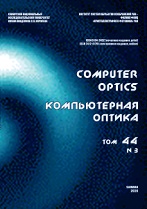|
This article is cited in 1 scientific paper (total in 1 paper)
DIFFRACTIVE OPTICS, OPTICAL TECHNOLOGIES
Superposition of two Laguerre-Gaussian beams shifted from the optical axis
V. V. Kotlyarab, A. A. Kovalevab, A. G. Nalimovab
a Image Processing Systems Institute of the RAS - Branch of the FSRC "Crystallography and Photonics" RAS, Samara, Russia, Samara
b Samara National Research University
Abstract:
Topological charges (TC) of a superposition of two Laguerre-Gauss (LG) beams $(0,~m)$ and $(0,~n)$ symmetrically shifted from the optical axis are found in this work. It is shown that if $m=n$, then the TC of the superposition is equal to $n$. That is, two identical off-axis LG beams have the net TC as that of a single LG beam. If $m<n$, then the net TC of the superposition can take one of four values: $TC1=(m+n)/2$, $TC2=TC1+1$, $TC3=TC1+1/2$, and $TC4=TC1–1/2$. Criteria for choosing one of the four TC values are also established. In the absence of the off-axis shift of the two LG beams, the net TC of the superposition is equal to $n$, i.e. the larger of the two TC. And for an arbitrarily small off-axis shift, the net TC either remains the same as it was before the shift, or decreases by an even number. This is explained by the fact that an even number of optical vortices with $TC=–1$ "comes" from infinity, which compensate for the same number of optical vortices with $TC=+1$ in the superposition. It is also interesting that when superimposing two off-axis LG beams with certain tilts to the optical axis such that the superposition is structurally stable, an infinite number of screw dislocations with $TC=+1$ are formed on some line. The net TC of such a superposition is infinite.
Keywords:
screw dislocations, topological charge, optical vortices
Received: 05.10.2021
Accepted: 13.10.2021
Citation:
V. V. Kotlyar, A. A. Kovalev, A. G. Nalimov, “Superposition of two Laguerre-Gaussian beams shifted from the optical axis”, Computer Optics, 46:3 (2022), 366–374
Linking options:
https://www.mathnet.ru/eng/co1024 https://www.mathnet.ru/eng/co/v46/i3/p366
|

|




 Contact us:
Contact us: Terms of Use
Terms of Use
 Registration to the website
Registration to the website Logotypes
Logotypes








 Citation in format
Citation in format 
